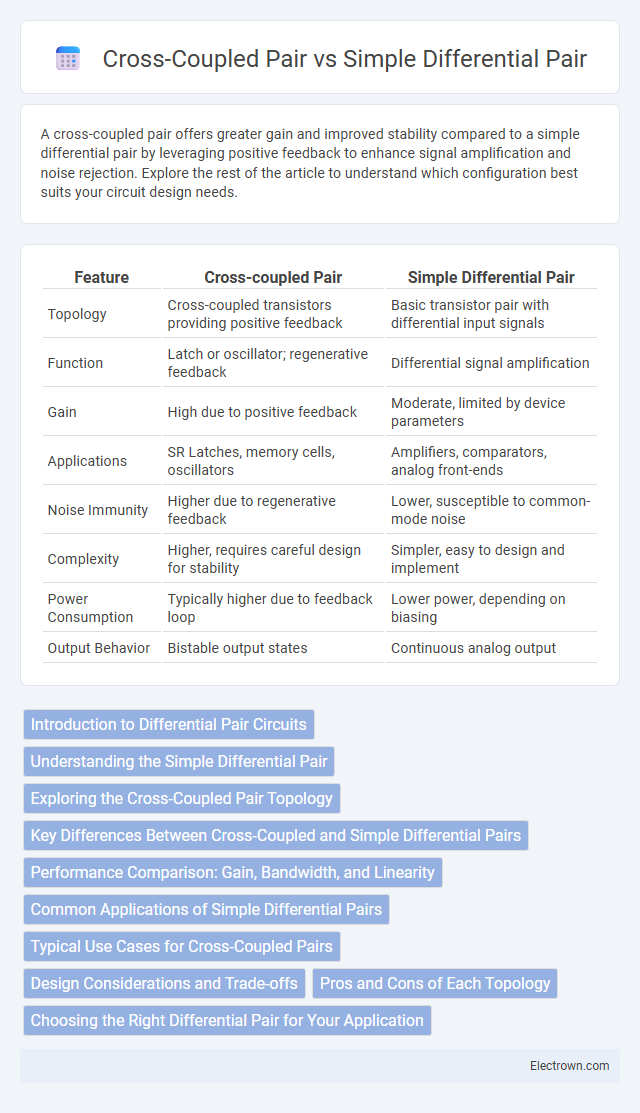A cross-coupled pair offers greater gain and improved stability compared to a simple differential pair by leveraging positive feedback to enhance signal amplification and noise rejection. Explore the rest of the article to understand which configuration best suits your circuit design needs.
Table of Comparison
| Feature | Cross-coupled Pair | Simple Differential Pair |
|---|---|---|
| Topology | Cross-coupled transistors providing positive feedback | Basic transistor pair with differential input signals |
| Function | Latch or oscillator; regenerative feedback | Differential signal amplification |
| Gain | High due to positive feedback | Moderate, limited by device parameters |
| Applications | SR Latches, memory cells, oscillators | Amplifiers, comparators, analog front-ends |
| Noise Immunity | Higher due to regenerative feedback | Lower, susceptible to common-mode noise |
| Complexity | Higher, requires careful design for stability | Simpler, easy to design and implement |
| Power Consumption | Typically higher due to feedback loop | Lower power, depending on biasing |
| Output Behavior | Bistable output states | Continuous analog output |
Introduction to Differential Pair Circuits
Differential pair circuits utilize two complementary transistors to amplify the difference between input signals while rejecting common-mode noise, essential in analog and mixed-signal designs. A simple differential pair provides basic differential gain and common-mode rejection but is limited in linearity and gain. Cross-coupled pairs enhance performance by incorporating positive feedback, increasing gain, improving input offset stability, and enabling oscillation in applications like voltage-controlled oscillators (VCOs) and memory cells.
Understanding the Simple Differential Pair
A Simple Differential Pair consists of two transistors with their emitters or sources connected together, forming a basic current mirror that amplifies the voltage difference between the inputs. It provides moderate gain and common-mode noise rejection, making it suitable for analog signal processing where simplicity and efficiency are priorities. Your choice of a Simple Differential Pair supports straightforward implementation and reliable differential amplification in integrated circuits.
Exploring the Cross-Coupled Pair Topology
The cross-coupled pair topology enhances gain and stability by using positive feedback loops between transistors, distinguishing it from the simple differential pair which relies on straightforward differential input signals. This configuration improves the common-mode rejection ratio (CMRR) and reduces offset voltage, making it ideal for precision amplification in your analog circuit designs. Engineers often select cross-coupled pairs to achieve better linearity and noise performance in integrated circuits.
Key Differences Between Cross-Coupled and Simple Differential Pairs
Cross-coupled pairs feature positive feedback, enhancing gain and speed compared to simple differential pairs, which rely solely on negative feedback for signal amplification. Simple differential pairs offer straightforward implementation and lower power consumption but exhibit limited gain and slower response times relative to cross-coupled configurations. The cross-coupled topology improves common-mode rejection ratio (CMRR) and linearity, making it preferable for high-performance analog circuit designs.
Performance Comparison: Gain, Bandwidth, and Linearity
Cross-coupled pairs exhibit higher gain and improved linearity compared to simple differential pairs due to positive feedback that enhances transconductance and reduces distortion. Bandwidth in cross-coupled configurations often narrows slightly because of increased parasitic capacitances, whereas simple differential pairs maintain broader bandwidth with moderate gain. The trade-off between gain and bandwidth must be balanced according to application requirements, with cross-coupled pairs favored for high-gain, low-distortion tasks and simple differential pairs preferred for wide-bandwidth designs.
Common Applications of Simple Differential Pairs
Simple differential pairs are widely used in high-speed communication interfaces, such as USB, HDMI, and Ethernet, due to their ability to reject common-mode noise and improve signal integrity. They also find applications in operational amplifier input stages and analog-to-digital converters, where precise differential signal measurement is crucial. The straightforward design and ease of implementation make simple differential pairs ideal for balanced signal transmission in mixed-signal circuits.
Typical Use Cases for Cross-Coupled Pairs
Cross-coupled pairs are commonly used in oscillator circuits and memory cells due to their ability to generate stable, self-sustaining oscillations and bistable states. These pairs excel in regenerative feedback applications, such as SRAM bit cells and ring oscillators, where rapid switching and noise immunity are critical. Their cross-feedback configuration enhances gain and speeds up the decision-making process compared to simple differential pairs, making them ideal for high-speed and low-power digital circuits.
Design Considerations and Trade-offs
Cross-coupled pairs offer stronger positive feedback, enhancing gain and latch functionality, which is ideal for high-speed and memory applications but introduces increased power consumption and complexity. Simple differential pairs provide better linearity and lower power dissipation, making them suitable for analog front-end circuits where precision and low noise are critical. Design trade-offs include balancing speed, power efficiency, noise immunity, and circuit stability based on application-specific requirements.
Pros and Cons of Each Topology
A cross-coupled pair offers high gain and improved stability in analog circuits but can suffer from increased power consumption and design complexity compared to a simple differential pair. The simple differential pair provides lower power consumption and straightforward implementation, making it suitable for basic amplification needs, though it may exhibit reduced gain and signal rejection capabilities. Designers must balance the robustness and performance advantages of cross-coupled pairs against the simplicity and efficiency of simple differential pairs based on application requirements.
Choosing the Right Differential Pair for Your Application
A cross-coupled pair offers improved gain and better linearity compared to a simple differential pair, making it ideal for high-frequency or precision analog circuits. Simple differential pairs are easier to design, consume less power, and provide sufficient performance for most general-purpose applications. Choosing the right differential pair depends on your application's requirements for gain, linearity, power efficiency, and complexity.
Cross-coupled Pair vs Simple Differential Pair Infographic

 electrown.com
electrown.com